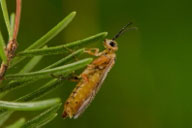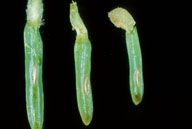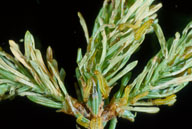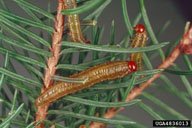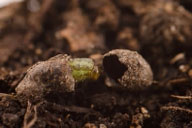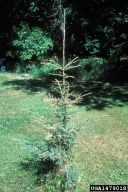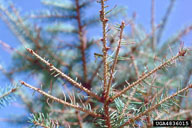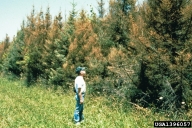Yellowheaded spruce sawfly
Pikonema alaskensis (Rohwer) (Hymenoptera: Tenthredinidae)
Orientation to pest
The yellowheaded spruce sawfly, Pikonema alaskensis (Rohwer), is a native sawfly found throughout northeastern and northwestern North America that feeds on all species of native and introduced spruce (Picea). It overwinters as prepupae in the duff and adults emerge in spring. Eggs are laid in the current season's needles just as buds begin to flush in the spring. Larvae feed on the new needles primarily, but may exploit old needles if new needles become scarce. In summer, fully developed larvae drop to the ground and spin cocoons (in which they molt to the prepupal stage) in the duff or topsoil. Damage occurs mainly in the upper crown of young, open-grown spruce, especially on trees in ornamental and shelterbelt plantings; mature trees are rarely attacked. Several years of heavy feeding may kill the leader and upper crown branches of trees. There is one generation per year.
Hosts commonly attacked
Hosts of yellowheaded spruce sawfly include all native spruces in North America: Engelmann (Picea engelmannii Parry ex Engelm.), white (Picea glauca [Moench] Voss), black (Picea mariana [Mill.] Britton, Sterns & Poggenburg), Sitka (Picea sitchensis [Bong.] Carr.), and Colorado blue (Picea pungens Engelm.), and the introduced Norway spruce (Picea abies [L.] Karst.).
Distribution
This sawfly occurs in throughout the range of spruce in North America, and can be found from Alaska to Maine, USA.
Images of yellowheaded spruce sawfly
| Figure 1. Adult of yellowheaded spruce sawfly, Pikonema alaskensis | Figure 2. Ovipostion cuts in needles made by yellowheaded spruce sawfly | Figure 3. Larvae of yellowheaded spruce sawfly; young larvae left and mature larvae, right | |
| Figure 4. Prepupa of yellowheaded spruce sawfly in cocoon (opened) | Figure 5. Damage (left) to white spruce from yellowheaded spruce sawfly; close up (right) of larvae feeding on spruce | Figure 6. Stand of spruce showing injury from yellowheaded spruce sawfly | |
Important biological control agents related to this pest species
The natural enemies of this species have been studied in Minnesota, Maine and Nova Scotia. A monitoring trap has been developed for one parasitoid, the ichneumonid Syndipnus rubiginosus Walley.
Web links for information on yellowheaded spruce sawfly
- Ecology and Management Page | North Central Forest Experiment Station, USDA Forest Service
General Technical Report NC-179 - Informational Page for Pest | Agricultural and Rural Development, Government of Alberta
- Fact Sheet | Natural Resources Canada
- Leaflet R10-TP-120 | USDA Forest Service Alaska Region
- IPM of Midwest Landscapes Fact Sheet | University of Minnesota
- Fact Sheet from Maine Forest Service | State of Maine Department of Conservation
- Fact Sheet on ForestPests.org | Vermont Division of Forestry
- Forest Insect & Disease Leaflet 69 | USDA Forest Service
Articles
- Thompson, L. C. and H. M. Kulman. 1980. Parasites of the yellowhead spruce sawfly, Pikonema alaskensis (Hymenoptera: Tenthredinidae), in Maine and Nova Scotia. The Canadian Entomologist 112: 25-29.
- Katovich, S. A., D. G. McCullough, and R. A. Haack. 1995.Yellowheaded spruce sawfly: its ecology and management. General Technical Report No. NC-179. US Forest Service. Michigan.
- Thurston, G. S. 2001. Pikonema alaskensis (Rohwer), yellowheaded spruce sawfly (Hymenoptera: Tenthredinidae), pp. 219-221. In: Mason, P. G. and J. T. Huber (eds.). Biological Control Programmes in Canada, 1981-2000. CABI Publishing, Wallingford, UK.
- Johns, R.C., D.P. Ostaff, and D.T. Quiring. 2006. Sampling procedures for evaluating yellowheaded spruce sawfly density and defoliation in juvenile black spruce stands. Journal of the Acadian Entomological Society 2: 1-12.
- Johns, R.C., D.P. Ostaff, and D.T. Quiring. 2006. Relationships between yellowheaded spruce sawfly density and defoliation on juvenile black spruce. Forest Ecology and Management 228: 51-60.
